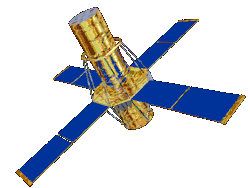

Scientific motivation is only part of what drives a space mission. Equally important are technical feasibility and, of course, cost. Given these considerations, a new mission to study the explosive release of energy during solar flares was proposed to NASA's Small Explorer (SMEX) program in 1997. This mission, the Ramaty High Energy Solar Spectroscopic Imager (RHESSI), was launched on February 5, 2002, from Kennedy Space Center. The RHESSI mission incorporates two important technological advances: the ability to obtain high-resolution spectra over a wide range of x-ray and gamma-ray energies, and the ability to image high-energy x-rays and gamma rays.
We have seen that spectra allow us to deduce the physical properties of the radiating particles in flares. The x-ray spectra that were available before RHESSI had generally been ambiguous: the spectra were not well determined and did not provide much information to allow models to be tested and compared. With RHESSI we are obtaining flare spectra that are much better determined, both because of higher spectral resolution and the broader range of photon energies that is covered. The lower energy end of these spectra allows us to consistently observe the hottest plasma in flares and study its relationship to the accelerated electrons producing nonthermal bremsstrahlung x-rays. The middle to high-energy end of the spectra allows us to consistently observe the energies to which electrons are accelerated and deduce whether more than one acceleration mechanism may be required. The constraints on models are much tighter.
Spectra from around 400 keV to about 10 MeV also contain gamma-ray lines. RHESSI has for the first time resolved many of these spectral lines, providing important information about accelerated protons and other ions (see Gamma-Ray Lines and Accelerated Ions).
Without imaging we can only observe the sum of the x-ray emission from all locations within a flaring region. For a complex flare such a spectrum can be hopeless to interpret. From the Yohkoh observations and our flare model we have seen that even for a simple flare critical information is lost without imaging. Using an imaging method that builds upon that employed on Yohkoh, RHESSI combines hard x-ray imaging with high-resolution spectroscopy to produce a unified spectroscopic imager. This instrument provides data from which images are constructed at any x-ray or gamma-ray energy, or spectra are obtained at any location within the flare.
Artist's concept of the Ramaty High Energy Solar Spectroscopic Imager (RHESSI)
Time resolution is also an important consideration for our spectroscopic imager, since flare emissions change rapidly with time. RHESSI builds up full flare images about once every two seconds. This allows us to follow the general evolution of hot plasma and accelerated particles throughout the duration of a flare. Flare data is taken on a time scale as short as one millisecond (0.001 second), however. We note that the time required for a 100 keV electron to travel directly from the top of the cusp of our model flare loop to one of the footpoints is on the order of 0.1 second. With this high-time-resolution data it is feasible to actually trace the motion of electrons within the flare loop.
![]() Learn more about RHESSI. Visit the Ramaty
High Energy Solar Spectroscopic Imager (RHESSI) Web Pages.
Learn more about RHESSI. Visit the Ramaty
High Energy Solar Spectroscopic Imager (RHESSI) Web Pages.
![]()
![]() Questions and Answers
Questions and Answers
![]() Back: Conclusions
Back: Conclusions
![]() Solar Flare Homepage
Solar Flare Homepage
![]() Table of Contents
Table of Contents